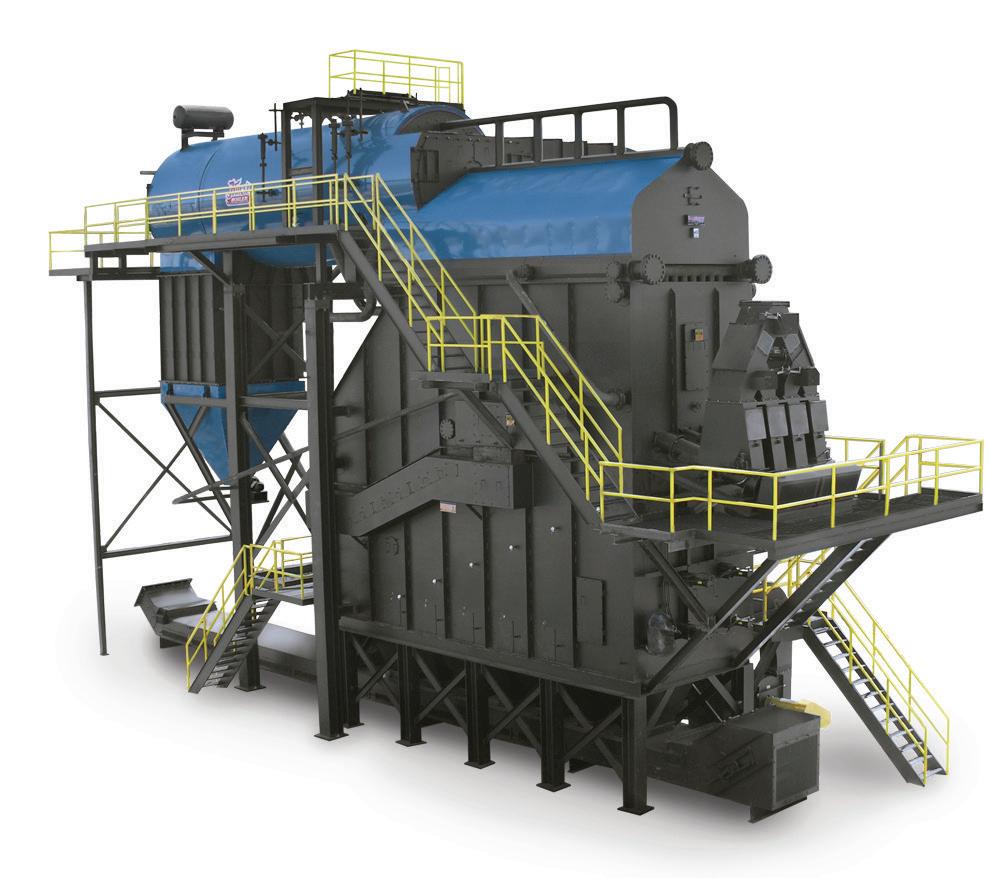
7 minute read
EVENT
ALL THINGS BIOMASS FROM YOUR DESKTOP
Via an innovative, accessible platform, the International Biomass Conference & Expo will held virtually March 16-17. BY ANNA SIMET
Despite the uncertainty and change that 2020 brought, the broader bioenergy industry has continued business as usual, adapting to change and working through challenges relatively unscathed. In fact, many sectors were quickly deemed as essential businesses that must continue operating during economic shutdowns.
Continuing its annual tradition of uniting the industry’s top experts, advocates, service and technology providers, academia, project developers and other stakeholders, the International Biomass Conference & Expo will take place March 16-17, marking its 14th consecutive year with a virtual event including all components of the traditional in-person event, from the association leader roundtable discussion, to a virtual trade show with online chat and video capabilities, to breakout panel discussions with opportunities to ask presenters live questions.
The following is a snapshot of the upcoming event, registration of which is free to producers of biomass heat and power, biogas, renewable natural gas and other biofuels, wood pellets and other densified biomass.
The annual association leader industry roundtable discussion, preceded by recognition of the Excellence in Bioenergy and Groundbreaker of the Year Award recipients, has served as the conference’s anchor event. “There’s a lot to talk about,” says Pellet Fuels Institute Executive Director Tim Portz. Portz highlights the recently passed BTU Act—which has been proposed every year for the past decade—as a major discussion topic. Included in the COVID-19 relief package in late December, the BTU Act grants a three-year investment tax credit for high-efficiency home heating equipment that fires wood pellets, chips or cordwood, beginning with 26% in 2021 and phasing down the next two years. “Clearly, this is a tremendous victory for the sector, but now the rubber hits the road,” Portz says. “How does the industry leverage this threeyear window to maximize the long term benefit? Moreover, with appliance sales numbers increasingly difficult to discern, how will fuel manufacturers know and anticipate the increased demand for pellet fuel that results from the credit?”
Other topics of interest to wood pellet producers specifically include fiber availability and BBQ pellet demand, according to Portz. “Wood pellet manufacturers operate at the mercy of available fiber,” Portz says. “Any expansion of wood pellet demand will put pressure on fiber inventories. That story is always a hyper-local one, but one that is uniquely felt by impacted producers.”
It would be difficult to imagine a more disruptive marketplace trend than soaring demand for cooking pellets, Portz adds. “Opportunities are there, but I know the industry and producers are already thinking about strategies to make sure both heating and cooking customer needs are met. For the good of the sector, we’ll need to be sure not to leave anyone out in the cold, so to speak.”
As for big ticket items for the biomass power industry, Annand says one is the policy outlook for the next few years. “This includes the USDA wood utilization and bioenergy support, as well as the prognosis for enabling electricity producers to participate in the renewable fuel standard,” she says. When Congress passed the RFS2 in 2007, it included electricity from qualifying renewable fuels as part of the program. However, 14 years later, the U.S. EPA still
Moderator
Anna Simet
Editor, Biomass Magazine
Tim Portz
Executive Director, Pellet Fuels Institute
Peter Thompson
Deputy Director, Biomass Thermal Energy Council
Patrick Serfass
Executive Director, American Biogas Council
Carrie Annand Seth Ginther
Executive Executive Director, Biomass Director, U.S. Power Association Industrial Pellet Association
hasn’t administered the program, disallowing biomass and biogas power and waste-to-energy power producers to generate RINs. For a deeper dive into this topic, Biomass Power Association CEO Bob Cleaves will be leading a panel dedicated eRINs, during the 1:30 p.m. biomass power and thermal track on March 16.
On biogas and RNG, Serfass says the industry is entering an interesting time. “RNG project development is booming at a time when the focus on renewable electricity is now also growing quickly,” he says. “And these changes are coming right as the politics in Washington are shifting blue. Historically, Democrats have been much more supportive of the renewable energy policy that has produced the fastest growth in the biogas industry. While the margins are thin, the American Biogas Council has expanded our staff to respond to what we hope will many new opportunities federally, and in a handful of states.
Following the general session discussion will be two days of track sessions held simultaneously in four different virtual rooms, allowing attendees to customize their content schedule by entering different rooms as they choose.
Track Sessions
With four categories including pellets and densifi ed biomass, biomass power and thermal, biogas and RNG as well as advanced biofuels and biobased chemicals, streaming track sessions will allow users to submit questions any time via chat to be answered live during or following presentations.
Track 1: Pellets & Densifi ed Biomass
With nine panels under this category, topics include international and domestic markets, forestry practices, combustible dust, fi re and explosion protection, emissions control and environmental compliance, and material handling.
The track kicks off with “International Market Outlook for Densifi ed Biomass,” which will feature four experts providing overviews and discussing trends of specifi c global markets. Speakers include the Wood Pellet Association of Canada Executive Director, Gordon Murray, who will provide an overview of the Canadian export market; Esben Vestergaard of RUF Briquetting Systems, who will discuss market possibilities for briquettes from a European perspective; Christiane Egger, deputy manager of Oekoenergie-Cluster, covering widespread heating pellet utilization in Upper Austria, and Annette Bossler, senior market intelligence export at FutureMetrics, who will present an overview of the Japanese pellet market.
Track 2: Biomass Power & Thermal
Perhaps the most versatile track, biomass power and thermal topics include policy and incentives, combustion and boiler innovations, combined-heat-andpower applications, torrefaction and pyrolysis.
For those with an interest in biochar, multiple panels will involve the increasingly popular topic, with “Understanding Biochar: Industry Trends and Opportunities” leading a run of panels involving biochar and/or pyrolysis and torrefaction. Experts presenting during this session include Suzanne Allaire, CEO of GECA Environnement, to discuss trends in biochar and biocoal production in North America; Tom Miles, principal of TR Miles Consulting Inc. and executive director of the U.S. Biochar Initiative, to present “New Opportunities for Biochar from Biomass Energy,” and Matt Young, a research engineer and University of Minnesota Duluth–Natural Resources Research Institute, to present “Engineering and Process Considerations when Using an Indirectly Heated Kiln for Biochar Research.”
Track 3: Biogas & RNG
Perhaps the fastest-growing industry sector, biogas and renewable natural gas may be the most increasingly popular

topic at the event. Project developers won’t want to miss the track’s fi rst panel, “RNG Project Development: Knowing the Market and the Rules.”
During this well-rounded panel covering key bases of project development, learn about emerging markets for RNG, presented by Brad Pleima, senior engineer at EcoEngineers; the legal components of projects, presented by David Gardels, partner at Hush Blackwell; and the ins and outs of fi nancing a biogas project.
Track 4: Advanced Biofuels & Biobased Chemicals
With an emphasis on feedstocks and supply chains, topics covered in this concentrated track include biofuel feedstock growth, storage and handling, as well as tools for analyzing biofuel feedstocks, including Carbon-14 testing and engineering supply chains.
Unique panel, “How Cellulosic Biofuel Production Can Parlay into Biomass Power,” may be of interest to biofuels, RNG and power stakeholders. The panel includes Jayant Godbole, president of PRAJ Americas Inc., presenting “Simultaneous and Sustainable Production of Cellulosic Ethanol & RNG from Agricultural Residues,” as well as Dane McSpedon, board member at Wilson Biochemical, presenting “Creation of Liquid Biofuels from Organic Fraction of MSW: UK Success,” and James DeSellem, advisory engineer at Babcock & Wilcox, presenting “Unlocking the Combustion Question for a Waste Stream.”
Virtual Trade Show
This year, exhibitors have the opportunity purchase virtual, customizable booths, which allow users to “man” their booths from any location and use the live chat or video function to hold discussions with visitors. “Based on data and feedback we have received from exhibitors from the multiple virtual events we have produced, we have discovered and been pleasantly surprised that exhibitors are able to easily engage in strong conversations with potential customers via live chat, disseminate branding materials, drive customers to their website and ultimately generate strong leads at their virtual booth,” says John Nelson, vice president of operations, sales and marketing at BBI International. “This is all online and digital, so we are able to generate reports and help exhibitors better identify potential customers during and after the show, because the virtual tradeshow is open for 30 days after the live event is complete.”
For more information or to register for the International Biomass Conference & Expo, visit www.biomassconference.com.
Author: Anna Simet Editor, Biomass Magazine 701-738-4961 asimet@bbiinternational.com

Rotary Dryers Sand Dryers Grain Dryers Lumber Kilns Cement Kilns Brick Kilns










